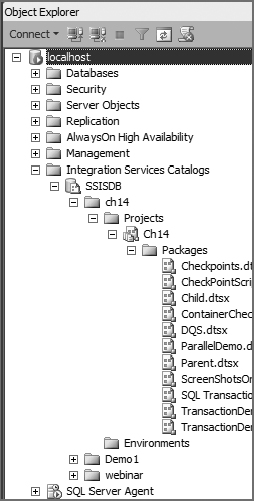Chapter 22
Administering SSIS
WHAT’S IN THIS CHAPTER?
- Using the SSIS catalog
- Choosing and using the different deployment models
- Using T-SQL with SSIS
- Managing security in SSIS
- Scheduling and monitoring packages
Welcome to the most exciting chapter in this book, the administration chapter. Okay, it is probably the most dreaded chapter, as administration tends to be a dry subject, but because SSIS changed so much in this release in terms of administration, this chapter is a must read for anyone who needs to execute, manage, and administer SSIS packages. You will learn how to parameterize, deploy, and administer the SSIS service. You will see the new SSIS catalog and how it will make executing packages much easier. You will also learn how to create a standalone ETL server and about some of the command-line utilities and the new T-SQL commands you can use to make your job easier. After reading this chapter, you’ll be able to create a package that doesn’t require any effort to migrate from development to production after the first deployment.
USING THE SSIS CATALOG
The SSIS catalog is new in SQL Server 2012. It is the central storage location for SSIS. Here you will administer projects, packages, parameters, and environments. Unlike the previous version of SSIS, you log in to the database engine in SSMS to work with the SSIS catalog, which is shown in Figure 22-1.


